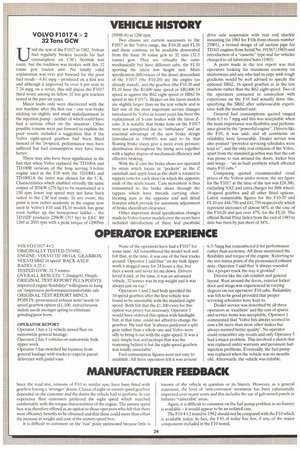VEHICLE HISTORY
Page 184

If you've noticed an error in this article please click here to report it so we can fix it.
VOLVO F10174 x 2 32 Tons GCW
ntil the test of the F1017 in 1982, Volvos had regularly broken records for fuel consumption on CM's Scottish test route, hut the tradition was broken with this 32 tonne gcw tractor unit. No totally valid explanation was ever put forward for the poor fuel result 6.81 mpg produced on a first test and although it improved by over 6 per cent to 7.24 mpg on a rerun, this still places the F1017 third worst among its fellow 32 ton gcw tractors tested in the past six years.
Minor faults only were discovered with the test machine after the first run one rear brake sticking on slightly and small maladjustment in the injection pump neither of which could have had a serious effect on the situation. Other possible reasons were put forward to explain the poor results included a suggestion that if the Volvo eight-speed gearbox had been fitted instead of the 16-speed, performance may have suffered but fuel consumption may have been better.
There may also have been significance in the fact that when Volvo replaced the TD100A and TD1OOB versions of the long serving 9.6-litre engine used in the F10 with the TD1000 and TD100GA the latter was chosen for the U.K. Characteristics which enabled virtually the same output of 203kW (276 hp) to be maintained at a 150 rpm lower top speed may not have been suited to the CM test route. In any event, the point is now rather academic as the engine now used in Volvo's F10 and FL10 models has gone even further up the horsepower ladder the TD102F produces 229kW (313 hp) to EEC 80/ 1269 at 2050 rpm with a peak torque of 1290Nm (950Ib ft) at 12(X1 rpm.
Two chassis are current successors to the F1017 in the Volvo range, the F10-20 and FL10 and these continue to be available downrated from the basic 38 tonne gcw to 32 tons (32.5 tonne) gcw. They are virtually the same mechanically but have different cabs. the FLIO sporting the latest low height unit. Main specification differences of the direct descendant of the F1017 (the F10-20) are the engine (as already stated), and the gearbox (the F10-20 and FLIO have the R1400 nine speed or SR1400 14 speed as against the R62 eight speed or SR62 16 speed in the F1017). Brakes on the latest models are slightly larger than on the test vehicle and in fact one of the most important service changes introduced by Volvo in recent years has been the replacement of S-cam brakes with the latest Zcam. It is notable that brake tests on the F1017 were not completed due to "imbalance" and an essential advantage of the new brake design (introduced in 1984/85) was said to be that floating brake shoes give a more even pressure distribution throughout the lining area together with a higher degree of mechanical efficiency and effective braking.
With the Z cam the brake shoes are operated by struts which locate in "pockets" in the Z camshaft and apply load as the shaft is rotated to tappets (one for each shoe) in which the opposite ends of the struts locate. Cam movement is thus transmitted to the brake shoes through the tappets which have threads carrying shoelocating nuts at the opposite end and detail features which provide for automatic adjustment of brake shoe/drum clearance.
Other important detail specification changes made to Volvo tractor modelsover the years have included introduction of three leaf parabolic drive axle suspension with rear end shackle mounting (in 1983 for FlOs from chassis number 25001), a revised design of oil suction pipe for TD101 engines from Serial No.191567 (1983) and introduction of a "cassette" type seal for vehicles changed to oil lubricated hubs (1983).
A point made in the test report was that operators looking for maximum economy on mortorways and any who had to cope with tough gradients would be well advised to specify the optional SR62, 16 speed gearbox as in the test machine rather than the R62 eight speed. Two of the operators contacted in connection with experience on the F10 had actually done this. specifying the SR62 after unfavourable experience with the standard unit.
General fuel consumptions quoted ranged from 6.5 to 7 mpg and this was acceptable when the main importance was flexibility and performance given by the "powerful engine". Drivers like the F10, it was said, and all comments on reliability were favourable. Dealer service was also praised "provided servicing schedules were kept to", and the only real criticism of the Volvo, apart from the standard gearbox was that the cab was prone to rust around the doors, locker box and wings "an in-built problem which affected many F10 cabs."
Comparing quoted recommended retail prices of the Volvos under review, the net figure for the F1017 at the time of the test was £28,380, excluding VAT and extra charges for fifth wheel, 16-speed gearbox and all other fitted options. Latest comparable figures for the F10-20 and FLIO are 144,750 and £41,750 respectively which represent increases of almost 60% in the case of the F10-20 and just over 47% for the FL10. The official Retail Price Index from the end of 1983 to date has risen by just short of 34%.
































































































































































































